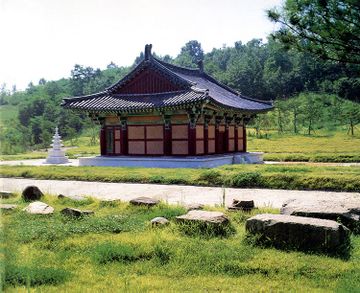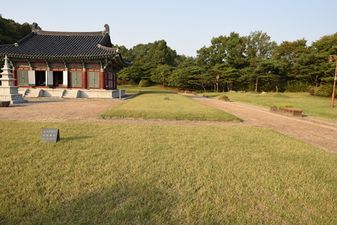청주 흥덕사지
| 청주 흥덕사지 |
|
| 대표명칭 | 청주 흥덕사지 |
|---|---|
| 한자 | 淸州 興德寺址 |
| 주소 | 충북 청주시 흥덕구 직지대로 713 |
| 지정(등록) 종목 | 사적 제315호 |
| 지정(등록)일 | 1986.05.07 |
|
|
|
해설문
| 국문 해설문 | 영문 해설문 |
|---|---|
| 흥덕사터는 1985년 발굴조사 결과 금당터와 강당터, 그리고 탑터와 이들을 둘러싼 회랑터의 일부가 발견되었다.
이와 함께 각종 기와와 전돌, 그릇 조각을 비롯하여, 청동으로 만든 금구(禁口), 작은종, 금강저(金剛杵) 등이 출토되었다. 현재의 모습은 발굴 결과에 의하여 금당과 삼층석탑을 복원한 것이다. 이곳은 현존하는 세계에서 가장 오래된 금속활자 인쇄본 「 백운화상초록불조직지심체요절(白雲和尙抄錄佛祖直指心體要節)」을 간행한 곳이다. 이 책은 1377년(고려 우왕 3)에 백운화상(1298~1374)이 「 불조직지심체요절」을 간추려 엮은 것을 그의 제자들이 금속활자로 인쇄한 것이다. 이 책은 독일 구텐베르크의 「 42행 성서」보다도 78년이나 앞서 인쇄된 것으로, 2001년 9월 4일 유네스코 '세계기록유산'에 등재되었다. 흥덕사터 인근에 청주고인쇄박물관이 건립되어, 인쇄와 관련된 문화의 변천과 발전 과정을 살펴볼 수 있다. |
This is the former site of the historic Heungdeoksa Temple, where Jikji (Anthology of Great Buddhist Priests' Zen Teachings), the world’s oldest book printed with movable metal type, was published.
This book was compiled by the Buddhist monk Baegun in 1372, and was printed by his disciples at the temple in 1377. This precedes the publication of the Gutenberg Bible by 78 years. In recognition of its significance, Jikji was registered in the UNESCO Memory of the World in 2001. The exact location of Heungdeoksa Temple had been unknown until 1985, when researchers found a bronze gong bearing an inscription of the temple's name during an excavation survey here. Other excavated artifacts include various tiles, bricks, miniature bronze bells, and a Buddhist ritual scepter. In accordance with this excavation survey, a prayer hall and a three-story stone pagoda have been reproduced on the site. The Cheongju Early Printing Museum, which shows the history of printing and publishing culture in Korea, was also built at the entrance to this historic temple site. |
위치
갤러리
금구에 새겨진 글씨[1]





